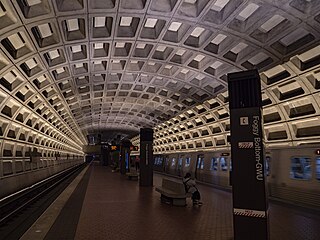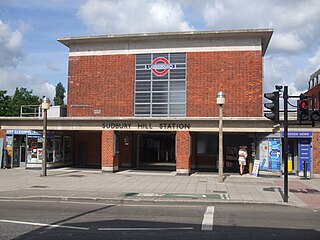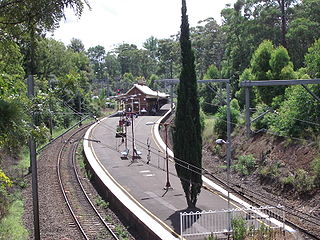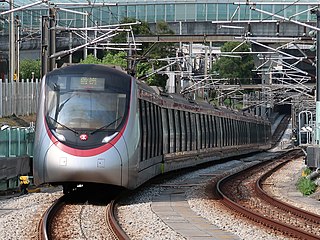
A cross-platform interchange is a type of interchange between different lines at a metro station. The term originates with the London Underground; such layouts exist in other networks but are not commonly so named. In the United States and Canada, it is often referred to as a cross-platform transfer.

South Kensington is a London Underground station in the district of South Kensington, south west London. It is served by the District, Circle and Piccadilly lines. On the District and Circle lines it is between Gloucester Road and Sloane Square, and on the Piccadilly line between Gloucester Road and Knightsbridge. It is in Travelcard Zone 1. The main station entrance is located at the junction of Old Brompton Road (A3218), Thurloe Place, Harrington Road, Onslow Place and Pelham Street. Subsidiary entrances are located in Exhibition Road giving access by pedestrian tunnel to the Natural History, Science and Victoria and Albert Museums. Also close by are the Royal Albert Hall, Imperial College London, the Royal College of Music, the London branch of the Goethe-Institut and the Ismaili Centre.

Farringdon is a London Underground and connected main line National Rail station in Clerkenwell, London, England, in the London Borough of Islington, just outside the boundary of the City of London. Opened in 1863 as the terminus of the Metropolitan Railway, the world's first underground passenger railway, Farringdon is one of the oldest surviving underground railway stations in the world.

Gloucester Road is a London Underground station in Kensington, west London. The station entrance is located close to the junction of Gloucester Road and Cromwell Road. Close by are the Cromwell Hospital and Baden-Powell House.

Barons Court is a London Underground station in West Kensington in the London Borough of Hammersmith and Fulham, Greater London. This station serves the District line and the Piccadilly line. Barons Court is between West Kensington and Hammersmith on the District line, and between Earl's Court and Hammersmith on the Piccadilly line and is in Travelcard Zone 2. East of the station, the Piccadilly line descends into tunnel towards Earl's Court and the District line continues in a cutting to West Kensington. The station is the last open air stop for eastbound trains on the Piccadilly line until Arnos Grove and has cross-platform interchange with the District line.

Bow Road is a London Underground station located on Bow Road in Bow, London, England. It is on the District and Hammersmith & City lines. The station is interlinked as an out of station interchange (OSI) with Bow Church station on the Docklands Light Railway which is about 300 m (980 ft) away via Bow Road. The two stations are classed as a single station for ticketing purposes as well as on tube maps but both are managed separately.

Foggy Bottom–GWU station is an Washington Metro station in the Foggy Bottom neighborhood of Washington, D.C., United States. The island-platformed station was opened on July 1, 1977, and is operated by the Washington Metropolitan Area Transit Authority (WMATA). Providing service for the Blue, Orange, and Silver Lines, the station is located on I Street on the George Washington University (GWU) campus. It is the last westbound station in the District of Columbia on these lines before they dive under the Potomac River to Virginia.

Sudbury Hill is a London Underground station on the Uxbridge branch of the Piccadilly line. The station is between Sudbury Town and South Harrow, and is in Travelcard Zone 4. It is located on Greenford Road (A4127) north of the junction with Whitton Avenue, on the border between the London Boroughs of Harrow and Ealing. The station is close to Sudbury Hill Harrow railway station.

Snowdon station is a Montreal Metro station in the borough of Côte-des-Neiges–Notre-Dame-de-Grâce in Montreal, Quebec, Canada. It is operated by the Société de transport de Montréal (STM) and is a transfer station between the Orange Line and Blue Line; it is the western terminus of the Blue Line. It is located in the Snowdon neighbourhood. The town of Hampstead is located nearby to the west, across Macdonald Avenue; one emergency exit from the station extends into Hampstead.

Admiralty is a MTR station in Admiralty, Hong Kong. The station's livery is blue and white. Served by the largest number of lines of any MTR station at four: the East Rail line, the Tsuen Wan line, the Island line, and the South Island line, Admiralty is a major interchange station within the MTR network.

Ho Man Tin is an underground MTR rapid transit station on the Kwun Tong line and the Tuen Ma line, located beneath Valley Road in Lo Lung Hang, as part of the Sha Tin to Central Link project. The station's lower platforms opened on 23 October 2016 along with Whampoa station as part of the Kwun Tong line extension, while the upper platforms of the Tuen Ma line opened on 27 June 2021.

Tin Hau is a station on the Island line of the Hong Kong MTR rapid transit system.

North Point is a station on the Hong Kong MTR Island line and the western terminus of the Tseung Kwan O line, located in North Point on Hong Kong Island. The livery of the station is tomato orange. The interchange between the Island line and the Tseung Kwan O line is a cross-platform interchange. It is also the northernmost station on the Island line.

An island platform is a station layout arrangement where a single platform is positioned between two tracks within a railway station, tram stop or transitway interchange. Island platforms are popular on twin-track routes due to economic and land use reasons. They are also useful within larger stations where local and express services for the same direction of travel can be provided from opposite sides of the same platform thereby simplifying transfers between the two tracks. An alternative arrangement is to position side platforms on either side of the tracks. The historical use of island platforms depends greatly upon the location. In the United Kingdom the use of island platforms is relatively common when the railway line is in a cutting or raised on an embankment, as this makes it easier to provide access to the platform without walking across the tracks.

The Nuremberg U-Bahn is a rapid transit system run by Verkehrs-Aktiengesellschaft Nürnberg, which itself is a member of the Verkehrsverbund Großraum Nürnberg. The Nuremberg U-Bahn is Germany's newest metro system, having begun operation in 1972, although the Nuremberg-Fürth route (U1) uses part of the right of way of the Bavarian Ludwig Railway, Germany's first passenger railway opened in 1835. The current network of the U-Bahn is composed of three lines, serving 49 stations, and comprising 38.2 kilometres (23.7 mi) of operational route, making it the shortest of the four metro systems in Germany, behind Berlin, Hamburg and Munich.

Wilshire/Vermont station is an underground rapid transit station on the B Line and D Line of the Los Angeles Metro Rail system. The station is located near the intersection of Wilshire Boulevard and Vermont Avenue, after which the station is named, in the Los Angeles neighborhood of Koreatown. Unlike the other stations on Wilshire or Vermont which were built directly under the street, this station is offset on a diagonal between the two streets, allowing the lines to diverge without trains on one line having to slow for a tight turn. The station has a unique layout with two side platforms on two levels, necessitated by the flying junction between the lines just west of the station. It is the last station going from Union Station that serves both the B Line and D Line.

Hongqiao Railway Station is a Shanghai Metro station located within the Shanghai Hongqiao railway station complex in the city's Minhang District. As part of a major transportation hub, it serves as an interchange between Lines 2, 10, and 17. It additionally serves as the western terminus the mainline service of Line 10, as well as the eastern terminus of Line 17. The station first opened as a Line 2 station on 1 July 2010, with Line 10 operations commencing on 30 November 2010. More than seven years later, Line 17 service was introduced with the opening of that line on 30 December 2017. With three island platforms totaling six platforms, the station is one of the largest in the system and features a cross-platform interchange between Lines 2 and 17.

The Tuen Ma lineis a rapid transit line that forms part of the Mass Transit Railway (MTR) system in Hong Kong. Coloured brown on the map, the Tuen Ma line is 56.2 kilometres (34.9 mi) in length, making it the longest line of the MTR network. It has a total of 27 stations, more than any other in the MTR system.

Rapid transit or mass rapid transit (MRT), also known as heavy rail or metro, is a type of high-capacity public transport that is generally built in urban areas. A rapid transit system that primarily or traditionally runs below the surface may be called a subway, tube, or underground. Unlike buses or trams, rapid transit systems are railways, usually electric, that operate on an exclusive right-of-way, which cannot be accessed by pedestrians or other vehicles. They are often grade-separated in tunnels or on elevated railways.

Paddington is a London Underground station served by the Bakerloo, Circle and District lines. It is located on Praed Street to the south of Paddington mainline station and has entrances from Praed Street and from within the mainline station. On the Bakerloo line the station is between Warwick Avenue and Edgware Road and on the Circle and District lines it is between Bayswater and Edgware Road. It is in London Fare Zone 1.




















